
Richmond is the capital city of the Commonwealth of Virginia in the United States. Incorporated in 1742, Richmond has been an independent city since 1871. The city's population in the 2020 census was 226,610, up from 204,214 in 2010, making it Virginia's fourth-most populous city. The Richmond metropolitan area, with over 1.3 million residents, is the Commonwealth's third-most populous.

Shortsville, officially the Village of Shortsville, is a village in Ontario County, New York, United States. The population was 1,439 at the time of the 2010 U.S. Census. Shortsville encompasses the southwestern part of the Town of Manchester and is located north of the City of Canandaigua.

The Richmond Times-Dispatch is the primary daily newspaper in Richmond, Virginia, and the primary newspaper of record for the state of Virginia.
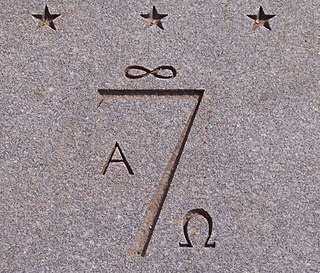
The Seven Society is the most secretive of the University of Virginia's secret societies. Members are only revealed after their death, when a wreath of black magnolias in the shape of a "7" is placed at the gravesite, the bell tower of the University Chapel chimes at seven-second intervals on the seventh dissonant chord when it is seven past the hour, and a notice is published in the university's Alumni News, and often in the Cavalier Daily. The most visible tradition of the society is the painting of the logo of the society, the number 7 surrounded by the signs for alpha (A), omega (Ω), and infinity (∞), and sometimes several stars, upon many buildings around the grounds of the university.
Virginius Dabney was an American teacher, journalist, and writer, who edited the Richmond Times-Dispatch from 1936 to 1969 and wrote several historical books. Dabney won the Pulitzer Prize for editorial writing in 1948 due in part to his opposition to the poll tax. In his later years, he became the first Rector of Virginia Commonwealth University.
The Confederate States of America (1861–1865) started with an agrarian-based economy that relied heavily on slave-worked plantations for the production of cotton for export to Europe and to the Northern US. If classed as an independent country, the area of the Confederate States would have ranked as the fourth-richest country of the world in 1860. But, when the Union began its blockade of Confederate ports in the summer of 1861, exports of cotton fell 95% and the South had to restructure itself to emphasize the production of food and munitions for internal use. After losing control of its main rivers and ports, the Confederacy had to depend on a delicate railroad system for transport that, with few repairs being made, no new equipment, and destructive raids, crumbled away. The financial infrastructure collapsed during the war as inflation destroyed banks and forced a move toward a barter economy for civilians. The Confederate government seized needed supplies and livestock. By 1865, the Confederate economy was in ruins.
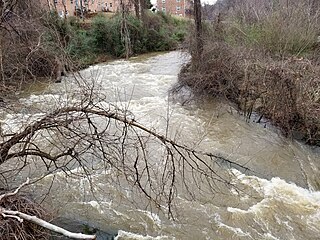
Falling Creek is a tributary of the James River located near Richmond, Virginia, United States. Approximately 23 miles (37 km) in length, it varies in width between 10 feet (3.0 m) at its source to several hundred feet in the Falling Creek Reservoir. Falling Creek rises in the Salisbury section of northwestern Chesterfield County, flows through Southside Richmond and empties into the James River roughly one mile south of the Richmond city limits. A dam located in the Meadowbrook section of the county at Hopkins Road forms the Falling Creek Reservoir, formerly used as northern Chesterfield's drinking water supply.

The Battle of Boydton Plank Road, fought on October 27–28, 1864, followed the Union Army's successful Battle of Peebles's Farm in the siege of Petersburg during the American Civil War. This follow up was a further success, with the Union Army able to seize the Boydton and Petersburg Plank Road and cut the South Side Railroad, a critical supply line to Petersburg, Virginia.

The Battle of Hatcher's Run, also known as Dabney's Mill, Armstrong's Mill, Rowanty Creek, and Vaughan Road, fought February 5–7, 1865, was one in a series of Union offensives during the siege of Petersburg, aimed at cutting off Confederate supply traffic on Boydton Plank Road and the Weldon Railroad west of Petersburg, Virginia.
Secret societies have been a part of University of Virginia student life since the first class of students in 1825. While the number of societies peaked during the 75 years between 1875 and 1950, there are several newer societies and seven societies that have been active for more than 100 years, including Seven Society, Z Society, IMP Society, Eli Banana, T.I.L.K.A. Society, and The 13 Society. The earliest societies, Eli Banana and T.I.L.K.A. Society, function as social clubs, while the Z Society, IMP Society, and Seven Society have a record of philanthropy and contribution to the university. Some of the more recent societies focus on the recognition or disapprobation of positive and negative contributions to the university.

Virginius Island is a formerly inhabited island of some 12 acres (4.9 ha), on the Shenandoah River in Harpers Ferry, West Virginia. The island was created by the Shenandoah Canal, constructed by the Patowmack Company between 1806 and 1807, which separates it from the town of Harpers Ferry. The canal was constructed to enable boats to bypass rapids on the river, and also channel water to drive machinery. In the nineteenth century Virginius Island contained Harpers Ferry's industry and working-class housing: a boarding house and row houses. Virginius Island is part of the Harpers Ferry National Historical Park.
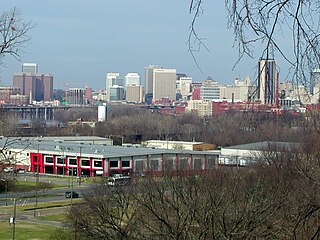
Fulton Hill is a neighborhood located in the East End of Richmond, Virginia. The name is used for the area stretching from Gillies Creek to the Richmond city limits. The Greater Fulton Hill Civic Association includes Fulton Bottom, part of Montrose Heights and part of Rocketts. Fulton Hill is south of Church Hill and Shockoe Bottom, north of Varina, east of the James River, and west of Sandston. The zip code is 23231.
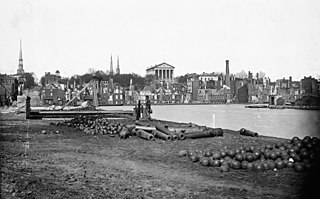
Richmond, Virginia, served as the capital of the Confederate States of America during the American Civil War from May 8, 1861, before that date the capital had been Montgomery, Alabama. Besides its political status, it was a vital source of weapons and supplies for the war effort, as well as the terminus of five railroads, and as such would have been defended by the Confederate States Army at all costs.
Warwick was an unincorporated town and port in Chesterfield County, Virginia, located on the navigable portion of the James River about 5 miles south of downtown Richmond, Virginia. Due to a sandbar in the river, although the falls did not begin until the river reached Richmond and Manchester, Warwick was as far upriver as many ships of the day could safely navigate. Regarding navigation on the James River, in his Notes on the State of Virginia, written in 1781–82, then-Governor Thomas Jefferson stated "Vessels of 250 tons may go to Warwick"

The Raven Society is an honor society at the University of Virginia in Charlottesville, Virginia. It was founded in 1904 by William McCully James who named it in honor of the poem by Edgar Allan Poe, who attended the University of Virginia in 1826.

Ampthill Plantation was located in the Virginia Colony in Chesterfield County on the south bank of the James River about four miles south of the head of navigation at modern-day Richmond, Virginia. Built by Henry Cary, Jr. about 1730, it was just upstream of Falling Creek. It was later owned by Colonel Archibald Cary, who maintained a flour mill complex and iron forge at the nearby town of Warwick. Mary Randolph was born there in 1762.
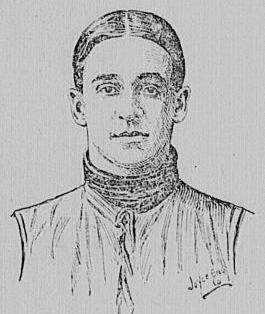
Virginius Dabney was an American college football player and coach. He served as the head coach at Tulane University in 1902.
Richmond Public Library is a public library in Richmond, Virginia. While many other libraries in the United States were provided initial funding by Andrew Carnegie, the City of Richmond famously rejected Carnegie funding twice.
The Virginia Commonwealth University School of the Arts is a public non-profit art and design school in Richmond, Virginia. One of many degree-offering schools at VCU, the School of the Arts comprises 18 bachelor's degree programs and six master's degree programs. Its satellite campus in Doha, Qatar, VCUarts Qatar, offers five bachelor's degrees and one master's degree. It was the first off-site campus to open in Education City by an American university.

The statue of the Confederate States of America cavalry general Williams Carter Wickham by Edward Virginius Valentine was installed in Richmond, Virginia's Monroe Park in 1891, near Virginia Commonwealth University's main campus. It was toppled in June 2020 during the George Floyd protests.















